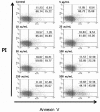The anti-obesity effect of Lethariella cladonioides in 3T3-L1 cells and obese mice
- PMID: 22259674
- PMCID: PMC3259292
- DOI: 10.4162/nrp.2011.5.6.503
The anti-obesity effect of Lethariella cladonioides in 3T3-L1 cells and obese mice
Abstract
The aim of this study was to investigate whether a water extract of L. cladonioides (LC) has an anti-obesity effect in 3T3-L1 cells and obese mice. Treatment of differentiated 3T3-L1 adipocytes with LC caused a significant increase in glycerol release and reduced the protein expression of the adipogenic transcription factors, PPARγ and C/EBPα. In an animal model, obese mice were artificially induced by a high fat diet for 10 weeks. Experimental groups were treated with LC (100 mg/kg/day) by gavage for the next 10 weeks. At the end of experiment, the body weight of the LC group mice was reduced by 14.2% compared to the high fat diet (HFD) group. The treatment also decreased liver (31.0%), epididymal (18.0%) and retroperitoneal (19.3%) adipose tissue, and kidney (6.7%) weights, respectively, compared with those of the HFD group. LC prevented diet-induced increases in the serum level of TC (22.6%), TG (11.6%), and glucose (35.0%), respectively, compared with the HFD group. However, the HDL-C level was higher in the LC group (26.1%) than the HFD group. The results of this study thus suggest that LC suppressed lipid accumulation and expression of adipogenic transcription factors, and increased the amount of glycerol release. LC also indicated an anti-obese and anti-hyperlipidemic effect.
Keywords: 3T3-L1 cells; Lethariella cladonioides; obese mice; obesity.
Figures






Similar articles
-
Fermented Platycodon grandiflorum Extract Inhibits Lipid Accumulation in 3T3-L1 Adipocytes and High-Fat Diet-Induced Obese Mice.J Med Food. 2016 Nov;19(11):1004-1014. doi: 10.1089/jmf.2016.3805. Epub 2016 Oct 28. J Med Food. 2016. PMID: 27792464
-
Acer tegmentosum Maxim Inhibits Adipogenesis in 3t3-l1 Adipocytes and Attenuates Lipid Accumulation in Obese Rats Fed a High-Fat Diet.Nutrients. 2020 Dec 7;12(12):3753. doi: 10.3390/nu12123753. Nutrients. 2020. PMID: 33297378 Free PMC article.
-
Pharmacological Properties of a Traditional Korean Formula Bojungchiseup-tang on 3T3-L1 Preadipocytes and High-Fat Diet-Induced Obesity Mouse Model.Biomed Res Int. 2020 Nov 27;2020:8851010. doi: 10.1155/2020/8851010. eCollection 2020. Biomed Res Int. 2020. PMID: 33313321 Free PMC article.
-
Annual Wormwood Leaf Inhibits the Adipogenesis of 3T3-L1 and Obesity in High-Fat Diet-Induced Obese Rats.Nutrients. 2017 May 28;9(6):554. doi: 10.3390/nu9060554. Nutrients. 2017. PMID: 28555033 Free PMC article.
-
Anti-Obesity Effects of Soy Leaf via Regulation of Adipogenic Transcription Factors and Fat Oxidation in Diet-Induced Obese Mice and 3T3-L1 Adipocytes.J Med Food. 2015 Aug;18(8):899-908. doi: 10.1089/jmf.2014.3388. Epub 2015 Mar 31. J Med Food. 2015. PMID: 25826408
Cited by
-
Screening for PPAR Non-Agonist Ligands Followed by Characterization of a Hit, AM-879, with Additional No-Adipogenic and cdk5-Mediated Phosphorylation Inhibition Properties.Front Endocrinol (Lausanne). 2018 Feb 1;9:11. doi: 10.3389/fendo.2018.00011. eCollection 2018. Front Endocrinol (Lausanne). 2018. PMID: 29449830 Free PMC article.
-
Potential of Coffee Fruit Extract and Quinic Acid on Adipogenesis and Lipolysis in 3T3-L1 Adipocytes.Kobe J Med Sci. 2018 Oct 15;64(3):E84-E92. Kobe J Med Sci. 2018. PMID: 30666038 Free PMC article.
-
The Demethoxy Derivatives of Curcumin Exhibit Greater Differentiation Suppression in 3T3-L1 Adipocytes Than Curcumin: A Mechanistic Study of Adipogenesis and Molecular Docking.Biomolecules. 2021 Jul 14;11(7):1025. doi: 10.3390/biom11071025. Biomolecules. 2021. PMID: 34356649 Free PMC article.
-
Cucurbitacin E reduces obesity and related metabolic dysfunction in mice by targeting JAK-STAT5 signaling pathway.PLoS One. 2017 Jun 9;12(6):e0178910. doi: 10.1371/journal.pone.0178910. eCollection 2017. PLoS One. 2017. PMID: 28598969 Free PMC article.
-
Anti-hyperlipidemic activity of Rhynchosia nulubilis seeds pickled with brown rice vinegar in mice fed a high-fat diet.Nutr Res Pract. 2013 Dec;7(6):453-9. doi: 10.4162/nrp.2013.7.6.453. Epub 2013 Nov 29. Nutr Res Pract. 2013. PMID: 24353830 Free PMC article.
References
-
- Poulos SP, Dodson MV, Hausman GJ. Cell line models for differentiation: preadipocytes and adipocytes. Exp Biol Med (Maywood) 2010;235:1185–1193. - PubMed
-
- Lee WJ, Koh EH, Won JC, Kim MS, Park JY, Lee KU. Obesity: the role of hypothalamic AMP-activated protein kinase in body weight regulation. Int J Biochem Cell Biol. 2005;37:2254–2259. - PubMed
-
- Shi Y, Burn P. Lipid metabolic enzymes: emerging drug targets for the treatment of obesity. Nat Rev Drug Discov. 2004;3:695–710. - PubMed
LinkOut - more resources
Full Text Sources
Miscellaneous

